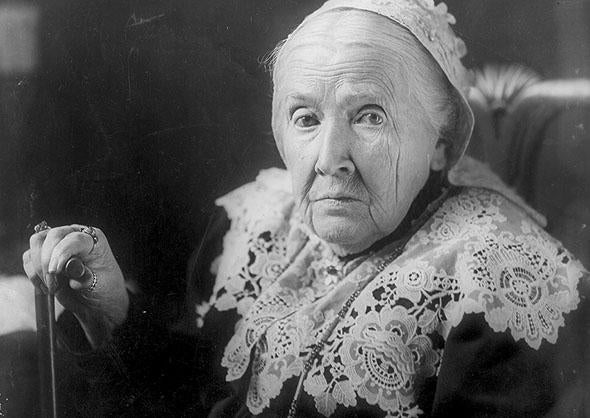Also in Slate: Why young women treat their mothers like friends. Giving birth 10,000 miles from home. And families affected by corrupt international adoption groups.

The hawking of Mother’s Day is hardly new. This year, within an hour, my e-mail inbox filled up with Plow & Hearth’s ads for “Pretty & practical outdoor gifts for Mom,” eBag’s promise to offer “Mother’s Day Markdowns,” Winter Silks’ idea on how “to pamper Mom with skin-soothing sleepwear,” and the Art Institute of Chicago’s high-brow message to “Honor Her with a Gift of Unique Beauty.”
Growing numbers of nonprofits have also joined the stampede to use Mother’s Day to sell their wares or solicit contributions. The liberal news site Buzzflash asks us to “Celebrate an Economically Just Mother’s Day by Helping Women Move From Welfare to Employment With the Purchase of These Eight Miniature Pastel Soap Hearts, Gift-Boxed.” If you detect a certain disconnect here, you’re not alone. Or consider the Sierra Club’s e-mail promising “Great Mother’s [Day] Gifts starting at $20” that will do “your part for the environment by sponsoring a wild place in her name.” Does the Sierra Club really have the right to name places in the wilderness after our mothers?
Do these nonprofit appeals exploit the holiday just like their commercial counterparts, or are they reclaiming the original meaning of the day? Perhaps the answer depends on whether the political cause that hitches itself to Mother’s Day has any connection to the lives of women or mothers—or to why the holiday first came into being.
The women who originally celebrated Mother’s Day conceived of it as an occasion to use their status as mothers to protest injustice and war. In 1858, Anna Reeves Jarvis organized Mother’s Work Days in West Appalachian communities to protest the lack of sanitation that caused disease-bearing insects and polluted water to sicken or even kill poor workers. In 1870, after witnessing the bloody Civil War, Julia Ward Howe—a Boston pacifist, poet, and suffragist who wrote the “Battle Hymn of the Republic”—proclaimed a special day for mothers to oppose war. Committed to ending all armed conflict, Howe wrote, “Our husbands shall not come to us reeking with carnage. … Our sons shall not be taken from us to unlearn all that we have been able to teach them of charity, mercy and patience.”
For the next three decades, Americans celebrated Mother’s Days for Peace on June 2. Women political activists of this era fought to end lynching and organized to end child labor, trafficking of women, and consumer fraud. In their view, their moral superiority was grounded in the fact of their motherhood.
When Anna Jarvis died in 1905, her daughter, also named Anna, vowed to honor her mother’s political activism by creating a national Mother’s Day. The gift card and flower industries also lobbied hard. As an industry publication, the Florists’ Review, put it, “This was a holiday that could be exploited.” In 1914, Congress responded and proclaimed the second Sunday in May to be Mother’s Day.
Companies seized on the holiday by setting out to teach Americans how to honor their mothers by buying them flowers, candy, or cards. This outraged Anna Jarvis the daughter. When florists sold carnations for the then-exorbitant price of $1 a piece, she began a campaign against “those who would undermine Mother’s Day with their greed.” But she was hardly a match for the flower and card companies. Soon, the Florists’ Review announced, with a certain triumphant tone, that it was “Miss Jarvis who was completely squelched.” And they were right.
And so a billion-dollar industry was born. Let’s be honest: Who among us dares ignore a holiday that has come to reflect our love and appreciation for our own mothers? And who among us doesn’t hope for just a few words of love and appreciation from our children? Maybe the nonprofits are offering a more virtuous way for us to show it. But what would Julia Ward Howe, who wanted Mother’s Day to promote peace and protest war, think about these organizations using the day to help them survive?
I’m not sure, but I have a suspicion that she would have looked more kindly upon those groups whose work tries directly to improve the lives of women and their families and to end war. The National Women’s History Project, for example, which lobbied Congress for Women’s History Month, asks its supporters to buy various gifts—cards and books and pins—for “the perfect mom.” The project is partly responsible for excavating previously invisible women like Jarvis and Howe, so making money from Mother’s Day makes sense in this case. The Feminist Majority Foundation, whose mission is to work for the “social and political and economic equality for women,” asks if you still “need a gift for Mother’s Day?” And then it assures you that “100% of proceeds go to continuing programs that support the advancement of women and girls worldwide.” MomsRising.org (an offshoot of MoveOn.org) is selling T-shirts for Mother’s Day to raise money for the group’s fight for paid sick leave, health care, child care, and other family friendly policies.
All these groups work to help women and mothers. But it is anti-war organizations like the Ploughshares Fund that return us to the original meaning of Mother’s Day. Ploughshares has always promoted peace. Its current e-mail asks you to sign a declaration for Ground Zero, a campaign to create a nuclear-free world. In making this request, Ploughshares urges, “After all, what better way to honor our mothers than to return to the holiday’s original purpose. … Reclaim the true meaning of Mother’s Day, and leave a peaceful legacy to our children.”
Now here’s a message the founding mothers of the holiday would have understood: just a simple request to sign a declaration demanding the destruction of nuclear weapons so that we leave a safer planet for our children. How delightfully quaint.